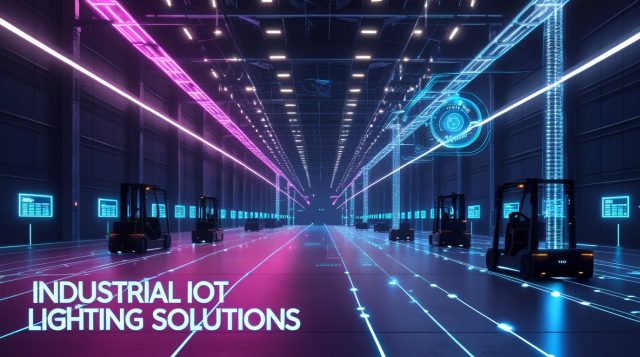The rhythmic hum of machinery fills the air as robotic arms weld chassis components with millimeter precision. Dozens of IIoT sensors track vibration, temperature, and throughput—data streaming toward the central dashboard where operations managers monitor real-time efficiency. Suddenly, the welding metrics freeze. Vibration alerts blink out. The production health score plummets without explanation. In the control room, engineers scramble to diagnose the issue, unaware that the culprit isn’t mechanical failure, but an invisible flaw in the facility’s wireless architecture.
This scenario unfolds daily in factories where Industrial Wi-Fi zoning—the strategic design of wireless coverage, channel allocation, and device segmentation—is an afterthought. While industry leaders chase AI-driven predictive analytics and cloud-based digital twins, they overlook a fundamental truth: Industrial AI cannot function without resilient, well-designed wireless infrastructure. For instance, robust wireless networks are critical for technologies like predictive maintenance AI, which can transform factory efficiency by anticipating equipment failures before they occur, as explored in Why Predictive Maintenance AI Leads Factory Efficiency in 2025.
The Invisible Epidemic: IIoT Failure Rates and the Wi-Fi Connection
Recent data reveals a harsh reality: almost 30% of IIoT projects fail at the proof-of-concept stage, while 75% take twice as long and run 45% over budget. Microsoft’s IoT Signals report identifies connectivity issues as a primary contributor, particularly in environments with:
- Legacy metal infrastructure
- High-density machinery layouts
- Electromagnetic interference (EMI) sources
- Multi-vendor device ecosystems
As Charlie McRae, Systems Engineer at IDS-INDATA, explains: “You can have the latest IIoT sensors, but if your signal can’t penetrate steel-clad factory floors or devices aren’t properly segmented, performance and reliability will implode.” This challenge is compounded when deploying advanced systems like edge AI, which relies on real-time data processing to reduce factory downtime, as discussed in Why Edge AI Industrial Sound Sensing Slashes Factory Downtime 2025.
Why Wi-Fi Zoning Isn’t Just “Coverage” – The Technical Breakdown
Industrial Wi-Fi zoning refers to the science of designing wireless networks for:
- Predictable Signal Propagation: Mapping RF pathways around obstructions
- Device Segmentation: Isolating critical IIoT traffic from non-essential devices
- Channel Optimization: Minimizing co-channel interference
- Capacity Planning: Ensuring bandwidth for data-intensive AI workloads
Poor zoning manifests in three catastrophic ways:
1. The Bottleneck Effect
Most industrial sites still rely on Cat5 cabling and 1 Gb switches—components utterly inadequate for Wi-Fi 7’s potential. When tri-band access points attempt 6 GHz transmissions through these legacy pathways, throughput craters. The result? Industrial AI systems starve for data.
Real Impact: A major automotive supplier abandoned real-time quality analytics when vibration sensor data took 47 seconds to reach their AI model—up from the 200ms requirement.
2. The Spectrum War
Wi-Fi 7’s 6 GHz band offers cleaner airways, but without zoning:
- Uncoordinated Access Points create “signal collisions” in high-density zones
- Legacy Wi-Fi 4/5 devices monopolize airtime with inefficient transmissions
- Non-IIoT devices (employee phones, tablets) congest channels
This explains why facilities report 37% packet loss during peak production despite “full coverage.” For deeper insights into how advanced wireless technologies are addressing these issues, Cisco’s guide on Wi-Fi 7 for industrial IoT highlights the importance of proper channel management to maximize throughput.
3. The Security MirageWPA3 encryption means nothing when:
- OT and IT share broadcast domains: A compromised tablet can sniff IIoT traffic
- Rogue APs go undetected: Unauthorized hotspots create backdoors
- No device profiling: Malicious nodes mimic legitimate sensors
As noted in Computers journal: “89% of industrial devices lack effective security measures”—often due to flat network designs. This vulnerability is particularly critical when integrating AI-driven cybersecurity solutions, which can detect and mitigate threats in real time, as outlined in AI-Driven Cybersecurity Threat Detection Master.
The AI Domino Effect: How Wireless Flaws Cripple Industrial Intelligence
Industrial AI’s promise hinges on three data fundamentals:
- Volume: High-resolution sensor streams
- Velocity: Sub-second latency
- Veracity: Uncorrupted, continuous packets
Poor Wi-Fi zoning sabotages all three:
► Predictive Maintenance Falls Blind
Vibration analytics require consistent 2 kHz sampling. Wireless dropouts create gaps that mask bearing wear patterns. One study showed false-negative rates surge 68% with >0.5% packet loss.
► Digital Twins Desynchronize
When real-time positional data from AGVs (Automated Guided Vehicles) arrives late, the virtual model drifts out of sync. Maintenance teams then act on stale insights—like recalibrating a robot that already moved. For a closer look at how digital twins are transforming industries, Industrial AI and Digital Twins Transform Industry in 2025 explores their role in optimizing operations.
► Quality Control Goes Reactive
Computer vision systems inspecting surface defects need 50+ Mbps sustained bandwidth. Channel congestion forces frame skipping, allowing flawed products to pass undetected.
Fictional Case: At “Vertex Plastics,” AI-driven extrusion line monitors falsely flagged 12% of products as defective due to thermal image fragmentation from wireless interference. Post-zoning redesign reduced false alerts by 91%.
Zoning in Practice: The Architecture of Resilient Industrial Wireless
Transforming Wi-Fi from liability to asset requires layered design:
Physical Layer Foundations
| Component | Minimum Spec | Zoning Impact |
|---|---|---|
| Cabling | Shielded Cat6A | Prevents EMI corruption |
| Switches | Multi-gig PoE++ | Powers high-gain APs |
| AP Placement | 15m max device spacing | Eliminates dead zones |
“Chasing Wi-Fi 7 without Cat6A cabling is like fueling a Ferrari with kerosene” – Network World, 2025
RF Zoning Strategies
- Sector-Based Segmentation: Divide facilities into zones (Production, Logistics, Adminseur Admin) with dedicated:
- Frequency bands (6 GHz for IIoT, 5 GHz for OT)
- Channel width (80 MHz for AI video, 20 MHz for SCADA)
- Airtime Fairness Policies: Prioritize IIoT traffic during peak cycles
- Dynamic Frequency Selection: Automatically shift channels when interference spikes
Pro Tip: Use 3D RF modeling tools like Ekahau to simulate metal obstructions before deployment. For additional guidance on RF planning, Aruba Networks’ industrial Wi-Fi design recommendations emphasize the importance of tailored RF strategies for complex environments.
Security Zoning Essentials
- PSK Isolation: Unique keys per device group prevent lateral movement
- Device Fingerprinting: Allow-lists MAC/OUI patterns for known IIoT vendors
- Microsegmentation: Tunnel critical sensors via encrypted VLANs
The AI-Zoning Symbiosis: Future-Proofing Your Wireless EdgeTomorrow’s AI-Native Wireless (AINW) platforms will embed intelligence into zoning:
- Self-Healing Channels: APs autonomously reconfigure based on machine learning interference forecasts
- Predictive Handoffs: Preseamless roaming for AGVs using digital twin trajectory models
- Anomaly-Triggered Quarantine: AI isolates suspect IIoT nodes before exploits occur
Early adopters like Siemens report 62% fewer wireless trouble tickets after deploying AI-driven zoning.
The Path Forward: A 5-Step Zoning Assessment
Before deploying another IIoT sensor:
- Conduct Spectrum Analysis: Identify “dirty” channels using tools like Wi-Fi Analyzer Pro
- Map Device Density: Plot IIoT concentrations (>20 devices/100m² demands sector zoning)
- Classify Traffic: Segment networks by criticality (Safety > Control > Monitoring)
- Benchmark Media: Replace Cat5e/Cat6 with Cat6A or fiber backbones
- Implement Continuous Monitoring: Deploy WIPS (Wireless Intrusion Prevention) with AI-driven baselining
The Bottom Line
Industrial Wi-Fi zoning isn’t about signal bars—it’s about architecting an electromagnetic environment where data flows like precision hydraulics. As IIoT deployments scale from hundreds to thousands of endpoints, and as AI demands real-time, uncompromised data streams, facilities treating wireless as an afterthought will join the 75% failure statistic. Those embracing zoning as core infrastructure will unlock Industrial AI’s trillion-dollar potential.
“The battle for Industry 4.0 supremacy will be won or lost in the RF shadows”
FAQ: Industrial Wi-Fi Zoning & IIoT Failure Prevention
Can’t I just add more access points to fix coverage gaps?
No. Adding APs without channel planning creates co-channel interference—like multiple people shouting in a room. Strategic zoning balances density with channel allocation.
How much does proper Wi-Fi zoning cost?
Typical zoning projects cost $12k–$50k for mid-sized facilities—less than 10% of average IIoT project overruns. ROI includes 40–70% reduction in unplanned downtime
Does Wi-Fi 7 solve zoning issues?
Not alone. While 6 GHz adds spectrum, zoning remains essential for managing interference, device segmentation, and backhaul capacity. Upgrades should follow—not precede—zoning.
Can AI fix poor zoning retroactively?
Partially. AI can optimize channels and detect issues, but can’t overcome physical layer flaws (cabling, AP placement). Zoning requires upfront design rigor.
How critical is zoning for safety-critical IIoT systems?
Non-negotiable. Safety sensors (e-stop monitors, gas detectors) demand <10ms latency. Only dedicated wireless zones with priority queuing guarantee this.



